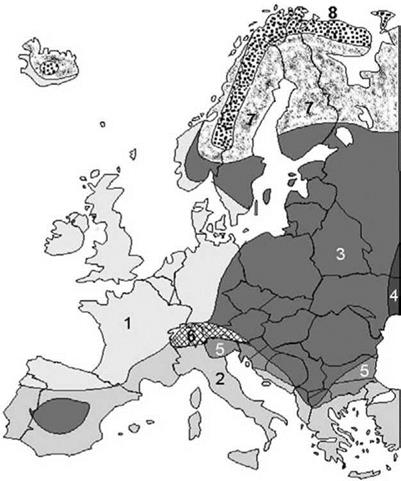Climate and Climate Change
The ultimate reason for having drainage is because of rain! Therefore the drainage needs and solutions will be heavily influenced by the climate where the road is built. Broadly, climate may be divided by temperature and by rain/snowfall. Typically climatologists further differentiate on temperature variation across the year and on rainfall distribution. A very commonly used classification that takes this approach is that due to Koeppen (McKnight and Hess, 2000). This divides the world into 5 major zones, each with subdivisions:
• Tropical – subdivided into Rain Forest, Monsoon and Savannah;
• Dry – subdivided into Desert and Steppe;
• Temperate – subdivided into Mediterranean, Sub-tropical, Maritime and Maritime Sub-polar;
• Continental – subdivided into Hot Summer, Warm Summer and Sub-arctic; and
• Polar – subdivided into Tundra and Ice-cap. Alpine climates can be grouped here, too, although their climate results from elevation, not latitude.
The characteristics of each climate will have major effects on the water in the road and adjacent ground. In particular, where the potential for evaporation is
|
Fig. 1.12 Simplified climatic zone map of Europe. 1 – Temperate, maritime; 2 – Temperate, Mediterranean; 3 – Continental, warm summer; 4 – Dry, steppe; 5 – Temperate, sub-tropical; 6 – Alpine; 7 – Continental, sub-arctic; 8 – Polar, undifferentiated |
significantly greater than rainfall, the effects of drainage may be less noticeable. However, this would need to be true throughout the year. Thus in tropical monsoon climates it may be true averaged over the year, but it is certainly not true during the wet season. It is at such a time that effective drainage may make the difference between survival of the road and its rapid deterioration.
Figure 1.12 shows a schematic division of Europe into the appropriate climatic zones.
In recent years the topic of climate change has become a consideration for almost everyone and road builders and operators are no exception. Temperature rise itself is unlikely to make a lot of difference to water in road structures in the warmer temperate areas, but in areas with seasonal freezing it could make a big difference. If the seasonal freeze period is reduced in length or lost or occurs repeatedly with intermittent thaw periods, then much longer periods of wet, non-frozen conditions (as currently experienced for shorter periods in the Autumn and Spring) can be expected, necessitating more stringent drainage requirements and causing much more frequent thaw-weakening problems. However, the shorter frozen period and the shallower penetration of the freezing front into the ground means that drainage trenches should more easily continue to operate year round.
Of likely importance to almost everyone is the increased rainfall that can be expected. Warmer ocean temperatures will lead to higher amounts of water in the atmosphere and, thus, more rain and snow. Whether this water will come regularly or in a few, but more severe, storms is less certain and the answer may vary by locality. The exact result may be difficult to predict, but the urgency for keeping water out of the pavement and associated highway earthworks can only increase. With greater runoff volumes anticipated, the need to provide positive drainage increases commensurately. Below ground it would be wise to anticipate greater volumetric flow rates of longer duration than previously experienced.







Leave a reply